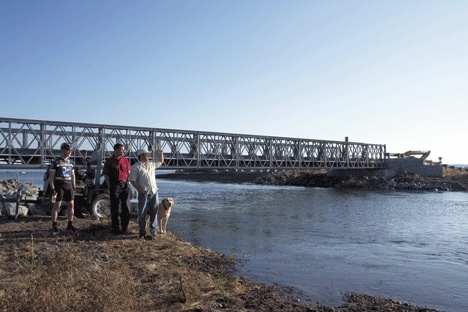The Crescent Harbor salt marsh began its recovery Wednesday evening as high tide rolled in at 6 p.m., an event that hasn’t been seen for nearly a century.
Matt Klope, a Navy wildlife biologist, took in the scene with his dogs and a small crowd of onlookers who stopped to make sense of the flooded pastureland.
“”We’re restoring it back to what it wants to be,” Klope said of the salt marsh that will support juvenile salmon habitat and estuary bird populations.
Small, one-foot waves appeared as the current rushed in, an event witnessed by Capt. Gerral David, Whidbey Island Naval Air Station commanding officer, as he took a break from a bike ride to join the group.
The scene was much different earlier in the day when a tour of city, county, tribal and Navy officials, including David and Rear Adm. James Symonds, gathered for a ceremonial final berm cut that allowed a trickle of brackish water to flow out toward the harbor.
As the tide rose, the current’s direction changed and saltwater poured into the century-old pastureland.
Whidbey Island’s Dutch farmers built a tidal gate in the early 1900s that transformed the 300-acre salt marsh into pasture land.
About 15 years ago, the Navy and Island County officials embarked on a wetland habitat restoration project that began with modifications to the early farmer’s tide gate. The project laid dormant until 1999 when the Puget Sound chinook salmon made the threatened species list.
The listing acted as a wake up call, causing Island County officials to identify the Crescent Harbor salt marsh as one of its highest ranking restoration opportunities. County officials worked with the Navy, the University of Washington’s Wetland Ecosystem Team and hydrologic consultants Philip Williams and Associates, Ltd., to prepare a feasibility study and create a basic project design.
A Navy construction battalion, the Seabees, removed a spoil berm in 2001 and installed a portable bridge in 2005 over the primary outflow culvert on E. Pioneer Way to continue vehicle access along the roadway.
For a time, the Seebees’ hard work confused passers-by, noted Oak Harbor Councilman Jim Palmer, who joked the metal span looked like “a bridge to nowhere,” over a giant hole in the ground as crews removed the remaining rocky soil to allow the harbor’s salty water to reclaim the marsh.
In 2007, the Navy contacted the Skagit River System Cooperative to help secure funding, complete the final designs and facilitate the project’s construction.
“We’ve partnered with a dozen agencies to get where we are today,” said Capt. David.
The teamwork paid off with a grant award from the Estuary and Salmon Restoration Program and Salmon Recovery Funding Board in 2007, allowing the project to move into its final design phase with engineering assistance from the Whidbey Island Conservation District.
The Crescent Harbor salt marsh project cost about $590,000, according to Steve Hinton, director of habitat restoration for the Skagit River System Cooperative.
The cooperative hired Northwest Construction that began the preliminary construction work last fall and resumed work on the project in early summer 2009 on the berm cuts, tidal channels and culvert replacement.
Chester Cayou, Jr. of the Swinomish Tribe spent the last month on site to oversee the project and watch for the possible unearthing of tribal artifacts. But nothing significant was found on the site that was a popular canoe landing spot hundreds of years ago, he said.
The Skagit River is the only waterway that supports all five native salmon species, said Swinomish Tribe Chairman Brian Cladoosby, noting that the Crescent Harbor marsh restoration is an integral part of supporting the salmon population.
“For every action there is a reaction,” he said.
“The benefit of projects like this cannot be overstated,” said Capt. David. “Not only does it directly benefit the environment and wildlife in Puget Sound, it clearly demonstrates the compatibility of the Navy’s mission with the natural resources that we share.”
Hours after the grip-and-grin ceremony, after the field flooded and the tide shifted back toward the harbor, John Mosher watched a trio of men aboard a small boat as they glided over the newly formed salt marsh. Mosher, a Northwest environmental liaison for the U.S. Pacific Fleet, worked on the project when it started 15 years ago.
“It’s really something to see after all this time,” he said.



